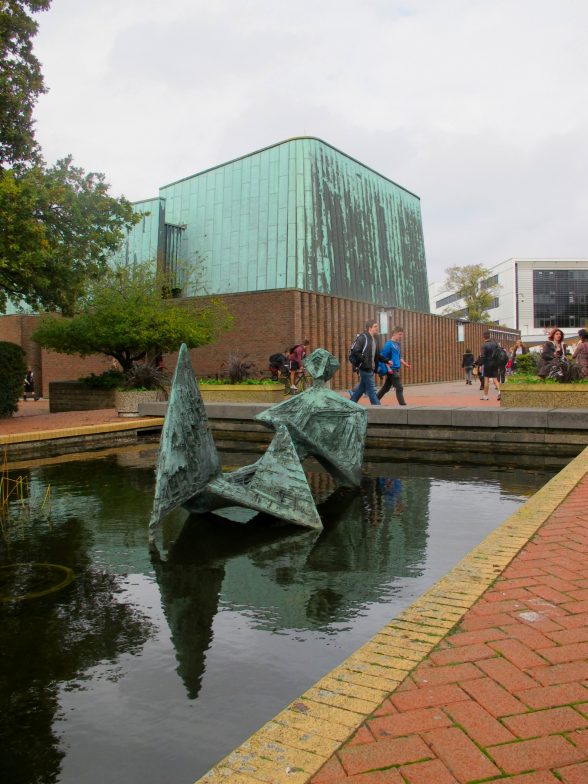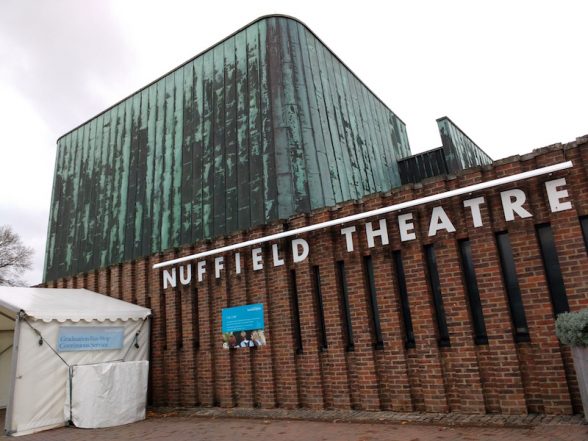This website uses cookies
This website uses cookies to enable it to function properly and to analyse how the website is used. Please click 'Close' to accept and continue using the website.



Photo: hapsnaps, Flickr
The Twentieth Century Society is delighted that Historic England has agreed to its application to list the Puy de Dôme sculpture which sits next to Sir Basil Spence’s Nuffield Theatre at Southampton University.
The abstract reclining nude figure, which has been listed at Grade II, is by Frederick Edward McWilliam. It is sited in a shallow rectangular pool designed by Sir Basil Spence. It is fixed on four points within the pool so that it rests just above the waterline, giving the impression that it is floating. The relationship with the pool is therefore very important to the work. It provides a mercurial base in which the weather produces changes in the character of the sculpture.
Basil Spence and Partners had been appointed to oversee the University’s development plan in 1956. Sir Basil Spence (1907-1976) was keen that alongside the new buildings, the campus should also feature sculpture and murals. In May 1961 Mary Chamberlain gave the university £2000 and Spence proposed that McWilliam produce a sculpture to be situated in a designed setting next to the Arts Building and theatre at the centre of the campus
The sculpture was inspired by a visit to the Puy de Dôme in Auvergne, a rounded volcanic plug at the heart of France’s Massif Central. It is immediately recognisable as by McWilliam because the subject recurs frequently in his work, and the way in which the figure is built up as a series of triangular form is very characteristic of this artist. At the time of the commission McWilliam was at a peak of his career. The sculpture is of high aesthetic quality and workmanship and compares well with other listed examples of his work.
McWilliam is described by Historic England as one of the country’s most important and prolific sculptors practising in the post-war period. Several of his public artworks have been listed including the Witch of Agnesi at the University of Greenwich (created 1959, installed 1960, Grade II), The Hampstead Figure to the north of Swiss Cottage Library (1964, Grade II).
The C20 Society also submitted a listing application for the adjacent Nuffield Theatre and has expressed dismay that this has been turned down.

The Nuffield theatre was built following a donation from the Nuffield Foundation. Southampton University did not have a drama department and did not intend to have one, yet was the first University in the country to have a theatre of its own. The auditorium design was based on the work of Dr Richard Southern, a stage historian who became the theatre’s Director of Drama. Southern worked on the Globe theatre in London and other ‘period’ theatres. Southampton did not have a regular playhouse at the time, so the Nuffield was built to serve ‘town and gown’, and was opened in March 1964 by Dame Sybil Thorndike.
It is a single-storey flat-roofed brick building, with recessed vertically-oriented slit windows and full-height recesses offering relief to the blank facades. The building’s primary decorative features are the copper rooftop enclosures for the projecting theatre fly tower and plant housing, the curves of which add a contrast to the otherwise rectilinear building. The feature is repeated on the roof of the Arts Building, a refined slab block clad in Portland stone. The building has a sculptural quality, composed of minimal forms and elevations, void of any visible servicing or structure, with the expressive copper rooftop forms referencing the ‘egg in a box’ concept made famous by Royal Festival Hall in the previous decade.
Catherine Croft, Director of C20, said: “We are very disappointed that the Nuffield Theatre was turned down for listing and that its future is uncertain but we hope the listing of the sculpture will mean that the architectural significance of Spence’s work on this site will be appreciated more and that the combined setting of both the theatre and the sculpture will be taken into account in any future plans.“

Become a C20 member today and help save our modern design heritage.